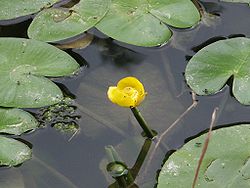Nuphar
| Habit | aquatic |
|---|
|
Nuphar > |
If this plant info box on watering; zones; height; etc. is mostly empty you can click on the edit tab and fill in the blanks!
Nuphar is genus of aquatic plants in the family Nymphaeaceae, with a temperate Northern Hemisphere distribution. The common name, shared with some other genera in the same family, is water lily or waterlily.
There are from 1 to 25 species in the genus. Some botanists[1] treat the genus as just a single variable species (for which the European name N. lutea has priority), but 10-12 species are typically accepted by most authorities. Recent molecular work has shown that there is some difference between the European and American species.[2]
The genus is closely related to Nymphaea (named after the Greek term "Νυμφαία", possibly related to "Νύμφη" meaning nymph). Nuphar differs in having its petals being much smaller than its 4-6 bright yellow-coloured sepals, whereas in Nymphaea, the petals are much larger than the sepals. The fruit maturation also differs, with Nuphar fruit being held above water level to maturity, whereas Nymphaea fruit sink below the water level immediately after the flower closes. Both genera share leaves with a radial notch from the circumference to the petiole (leaf stem) in the center.
Read about Nuphar in the Standard Cyclopedia of Horticulture
|
|---|
|
Nuphar (from the Arabic). Nymphaea of some authors. Nymphaeaceae, Spatter-dock. Yellow PondLily. Several aquatic plants of the North Temperate Zone, with stout rootstocks creeping in the mud. Leaves large, cordate-ovate or sagittate, some of which may be submerged and others either floating or standing erect above the water: fls. usually standing above the water, yellow or purplish, single on the scapes, the 5 or more large concave sepals constituting the showy part of the fl.; petals mostly numerous, small and simulating stamens, the latter numerous and short; ovary short, globular-ovoid, with 8-24 stigmas forming rays on its top: fr. an emersed caps.—Most of the nuphars are N. American. They grow in stagnant pools or on the margins of slow - running mud- bottom streams. Several species have been offered by dealers, but most of them have small value for the cultivator, although the foliage effects of N. advena may be striking. For cult., see Nymphaea and Aquatics.
|
Cultivation
Propagation
Pests and diseases
Species
About 10-15 species, including:
Nuphar advena
Nuphar japonica
Nuphar kalmiana
Nuphar lutea - Yellow Water-lily
Nuphar microphylla
Nuphar orbiculata
Nuphar polysepala
Nuphar pumila - Least Water-lily
Nuphar rubrodisca
Nuphar saggitifolia
Nuphar shimadae
Nuphar ulvacea
Nuphar variegata
Gallery
References
- ↑ Beal, E. O. (1956). "Taxonomic revision of the genus Nuphar Sm. of North America and Europe". Journal of the Elisha Mitchell Scientific Society 72: 317–346.
- ↑ Wiersema, John H.; C. Barre Hellquist (1997). "Nymphaeaceae". Flora of North America 3. http://www.efloras.org/florataxon.aspx?flora_id=1&taxon_id=122531.
- Standard Cyclopedia of Horticulture, by L. H. Bailey, MacMillan Co., 1963
External links
- w:Nuphar. Some of the material on this page may be from Wikipedia, under the Creative Commons license.
- Nuphar QR Code (Size 50, 100, 200, 500)
